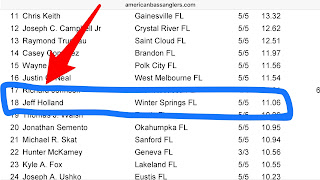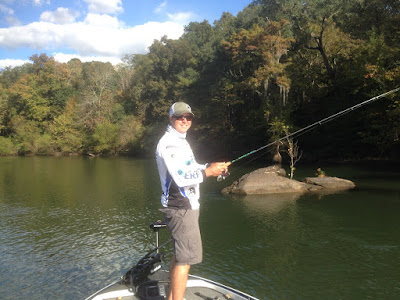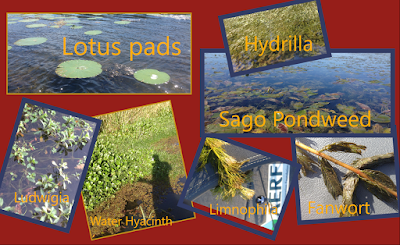After four years on the Bassmaster Southern Open bass tournament circuit I learned first-hand how important it was for anglers to fish instinctively. Balancing a family life, career, and competitive fishing life takes constant work. With all the family events, work duties, tournament travel miles, sponsor obligations, charity work, and social media production, there is little time left to spend on the water before each tournament.
For me, fishing patterns found in practice are over rated. In nearly every major tournament event I have participated in, the fishing pressure and weather encountered during the tournament week cancelled out any fishing patterns I developed in practice anyway. So why should I stress about practice? I always found myself developing new fishing patterns each tournament day anyhow.
To prove my point, my highest finish over my four-years on Bassmaster Southern Open Tour was on Douglas Lake, TN in April 2013. This was a reservoir I had never fished or seen before. It was a deep reservoir that fluctuated 40 feet annually. I drove up on Saturday and managed three days for practice before the Thursday start. I found cold water temperatures and lethargic bass, a massive shad die-off, and extremely cold weather. My Florida-style of fishing only landed me one keeper bass in three anxiety-filled days of practice. I felt horrible about my chances, but I never felt out if the game.
In that tournament I was forced to find bass in the coldest, muddiest water (47F) I had ever fished. I successfully developed a technique and lure combination using a bait I never used before, a jig. Knowing that northern anglers rely on jigs in the wintertime, I tied one on in the cold rain and slowly worked steep rock bluffs down to 45 feet deep. I was rewarded with two days of solid limits of bass and a 22nd place finish out of 182 pro anglers! The pros I beat that day were Bassmaster Classic Champions and Elite pro's: Casey Ashley, Randy Howell, and Paul Elias, Aaron Martens, Gerald Swindle, Brandon Palaniuk, and Kieth Poche!
I didn't realize it at the time, but that was my first major success fishing instinctively and with an open mind!
In 2016, I decided to take the year to work on my mental fishing game and market my sponsors to a more local, yet large grassroots audience. The long-term value to developing my instinctive style of fishing will pay off in the future. The pure fishing philosophies showcased by Major League Fishing Selects and Bassmaster Elite Bracket events are the wave of the future.
My scouting days on a lake or river now utilize the power of my Lowrance HDS9-Touch Gen3 unit to help understand lake conditions and fish movements. The technology has advanced so well it easily helps me find bass and bait-fish in the areas I intend to fish.
The other factor in my scouting has been to follow the teachings of Bassmaster Elite professional Rick Clunn in how I scout for bass. His theories covered all seasons (winter, spring, summer and fall) as bass are fairly predictable in their seasonal life cycles. Click here to read the UltimaterBass.com copy of Rick Clunn's theories.
How deep I fish each season is closely based on Buck Perry's structure fishing theories: 1) the home of the fish is located in deep water, and 2) 90% of the big bass are in 10% of the water.
How deep I fish each season is closely based on Buck Perry's structure fishing theories: 1) the home of the fish is located in deep water, and 2) 90% of the big bass are in 10% of the water.
Hooking Bass In Practice
Another way my new approach helps me is in the fact that I don't hook a lot of my fish in practice. Most of my tournaments occur on Saturdays on lakes that get fished heavily by a lot of anglers. These highly-pressured bass are already weary of anglers, so why would I hook bass and make them wise to my lures in practice? I have done that before, and while I may have "won in practice", the results rarely transferred over into my tournaments. The goal is for me win on tournament day, not in practice.
Another way my new approach helps me is in the fact that I don't hook a lot of my fish in practice. Most of my tournaments occur on Saturdays on lakes that get fished heavily by a lot of anglers. These highly-pressured bass are already weary of anglers, so why would I hook bass and make them wise to my lures in practice? I have done that before, and while I may have "won in practice", the results rarely transferred over into my tournaments. The goal is for me win on tournament day, not in practice.
My tournament competitors are typically younger pro anglers, local guides, and a variety of anglers with tremendous time on their hands. They normally have an advantage during stable conditions due to their vast time on the water. If any aspect of the weather, wind, or current changes, those anglers are commonly lost for a few hours. I feel my "open-minded" approach helps me evaluate the bass quicker and gives ME the advantage.
My approach is nothing new, just look at the similar challenges the bass pros are faced with in Major League Fishing. Their rules force them to fish unknown waters with no practice or previous research! Check out the show here if you've never seen it.
Full-time Elite anglers always seem to know what the fish are doing and how to catch them. Not the case with me: I may know about aquatic plants, have a good understanding of lake biology, but bass behavior still eludes my full comprehension. I still have those days where I get beat in tournaments and leave the water not sure where I went wrong. But those days are fewer, and my quest for a free-style fishing approach has raised my confidence level higher than I ever dreamed possible.
However, I warn other anglers that this journey is only for hard-core fish heads. It will totally mess up your psyche and play more mind games than you ever imagined in a tournament!
The journey will be similar to a multi-car wreck in a NASCAR race, once you drive through the smoke of the mental wreck, you may just come out as the lead car!
 |
| My free-style approach is a mental wreck - get through the smoke and may be in the lead |
The journey will be similar to a multi-car wreck in a NASCAR race, once you drive through the smoke of the mental wreck, you may just come out as the lead car!
In this and future blogs, I will continue share my journey for mastering the technique of "instinctive fishing" that leads more to "fishing in the moment".
Please stay with me on this journey! Jeff
Please stay with me on this journey! Jeff










































